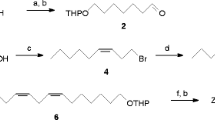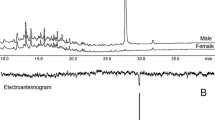Abstract
Although adult sycamore lace bugs Corythucha ciliata (Say) show no sign of aggregation, nymphs at all developing stages are gregarious. When an individual nymph in the center of a colony was squashed with a needlepoint, proximate nymphs showed evasive behavior. The same evasive reaction was produced by exposing aggregated nymphs to nymph hexane extract. The active component, E-3,7-dimethyl-2,6-octadien-1-ol, geraniol, was responsible for the evasive behavior, and identified as the alarm pheromone. One nanogram of the alarm pheromone elicited activity similar to that in a third instar nymph. Presence of 2-acylcyclohexane-1,3-diones and their 4-hydroxy analogues are reconfirmed as nymph-specific components, though their biological significance remains unknown.




Similar content being viewed by others
References
Aldrich, J. R., Neal Jr., J. W., Oliver, J. E., and Lusby, W. R. 1991. Chemistry vis-à-vis maternalism in lace bugs (Heteroptera: Tingidae): alarm pheromones and exudate defense in Corythucha and Gargaphia species. J. Chem. Ecol. 17:2307–2322.
Chung, Y. J., Kwong, T. S., Yeo, W. H., Byun, B. K., and Park, C. H. 1996. Occurrence of the sycamore lace bug, Corythucha ciliata (Say) (Hemiptera: Tingidae) in Korea. Korean J. Appl. Entomol. 35:137–139.
Corbet, S. A. 1971. Mandibular gland secretion of the flour moth, Anagasta kuehniella contains an epideictic pheromone and elicits oviposition movements in a hymenopteran parasite. Nature 232:481–4.
Corbet, S. A. 1973. Oviposition pheromone in larval mandibular glands of Ephestia kuehniella. Nature 243:537–8.
D’aguilar, R. P., Rabasse, J. M., and Mouton, R. 1977. Introduction en France du tigre du platane: Corythucha ciliata (Say) (Het. Tingidae). Bulletin de la Société Entomologique de France 82:1–6.
Drake, C. J., and Ruhoff, F. A. 1965. Lacebugs of the World, a Catalogue (Hemiptera: Tingidae). U. S. National Museum Bulletin 243.
Eller, F. J., Bartelt, R. J., Shasha, B. S., Schuster, D. J., Riley, D. G. Stansly, P. A., Mueller, T. F., Shuler, K. D., Johnson, B., Davis, J. H., and Sutherland, C. A. 1994. Aggregation pheromone for the pepper weevil, Anthonomus eugenii Cano (Coleoptera: Curculionidae): Identification and field activity. J. Chem. Ecol. 20:1537–55.
Free, J. B., Ferguson, A. W., and Pickett, J. A. 1981. Evaluation of the various components of the Nasanov pheromone used by clustering honeybees. Physiolog. Entomol. 6:263–8.
Halbert, S. E., and Meeker, J. R. 1998. The sycamore lace bug Corythucha ciliata (Say)(Hemiptera: Tingidae). Entomol. Circular Gainesville 387:2.
Kearns, R. S., and Yamamoto, R. T. 1981. Maternal behavior and alarm response in the eggplant lace bug, Gargaphia solani Heidemann (Tingidae: Heteroptera). Psyche 88:215–230.
Kuwahara, Y. 2004. Chemical ecology in astigmatid mites. pp76-109 in: Advances in Insect Chemical Ecology, Eds. Carde, R.T. and Millar, J.G. Cambridge University Press.
Kuwahara, Y., Nemoto, T., Shibuya, M., Matsuura, H., and Shiraiwa, Y. 1983. 2-Palmitoyl- and 2-oleoyl-cyclohexane-1,3-dione from feces of the Indian meal moth, Plodia interpunctella: Kairomone components against a parasitic wasp, Venturia canescens. Agric. Biol. Chem. 47:1929–1931.
Lusby, W. R., Oliver, J. E., Neal Jr., J.W., and Heath, R. R. 1987. Isolation and identification of the major component of setal exudate from Corythucha ciliata. J. Nat. Prod. 50:1126–1130.
MUDD, A and CORBET, S. A. 1973. Mandibular gland secretion of larvae of the stored products pests Anagasta kuehniella, Ephestia cautella, Plodia interpunctella, and Ephestia elutella. Entomol. Exper. Applic. 16:291–3.
Nemoto, T., Shibuya, M., Kuwahara, Y., and Suzuki, T. 1987a. New 2-acylcyclohexane-1,3-diones: Kairomone components against a parasitic wasp, Venturia canescens, from feces of the almond moth Cadra cautella, and the Indian meal moth, Plodia interpunctella. Agric. Biol. Chem. 51:1805–1810.
Nemoto, T., Kuwahara, Y., and Suzuki, T. 1987b. Interspecific difference in Venturia kairomones in larval feces of four stored phycitid moths. Appl. Entomol. Zool. 22:553–559.
Noge, K., Kato, M., Mori, N., Kataoka, M., Tanaka, C., Yamasue, Y., Nishida, R., and Kuwahara, Y. 2008. Geraniol dehydrogenase, the key enzyme in biosynthesis of the alarm pheromone, from the astigmatid mite, Carpoglyphus lactis (Acari: Carpoglyphidae). FEBS J. 275:2807–2817
Öszi, B., Ladányi, M., and Hufnagel, L. 2005. Population dynamics of the sycamore lace bug, Corythucha ciliata (Say) (Hemiptera. Tingidae) in Hungary. App. Ecol. Environ. Res. 4:135–150.
Peicart, J. 1982. The Hemiptera Tingidae: systematic position, morphology, biology and economic importance. Bull. la Société Entomologique de France 87:5–6.
Prado, C. E. 1990. Presence in Chile of Corythucha ciliata (Say) (Hemiptera: Heteroptera: Tingidae). Revista Chilena de Entomologia 18:53–55.
Tokihiro, G., Tanaka, K., and Kondo, K. 2003. Occurrence in Japan of the sycamore lace bug, Corythucha ciliata (Say) (Hemiptera. Tingidae), named newly as “puratanasu gunnbai” in Japanese. Res. Bull. Pl. Prot. Japan 39:85–87. (Japanese)
Tokumaru, S., Ueyama, H., Kurita, H., and Nakajima, S. 2010. Geographical distribution of Corythucha ciliata (Say) (Heteroptera. Tingidae) in Kyoto Prefecture. Appl. Entomol. Zool. (Japanese), in press.
Acknowledgments
We wish to thank Miss Maiko Ueno, Kyoto Gakuen University, for helping to collect the sycamore lace bugs and for technical assistance.
Author information
Authors and Affiliations
Corresponding author
Rights and permissions
About this article
Cite this article
Kuwahara, Y., Kawai, A., Shimizu, N. et al. Geraniol, E-3,7-dimethyl-2,6-octadien-1-ol, as the Alarm Pheromone of the Sycamore Lace Bug Corythucha ciliata (Say). J Chem Ecol 37, 1211–1215 (2011). https://doi.org/10.1007/s10886-011-0025-2
Received:
Revised:
Accepted:
Published:
Issue Date:
DOI: https://doi.org/10.1007/s10886-011-0025-2




